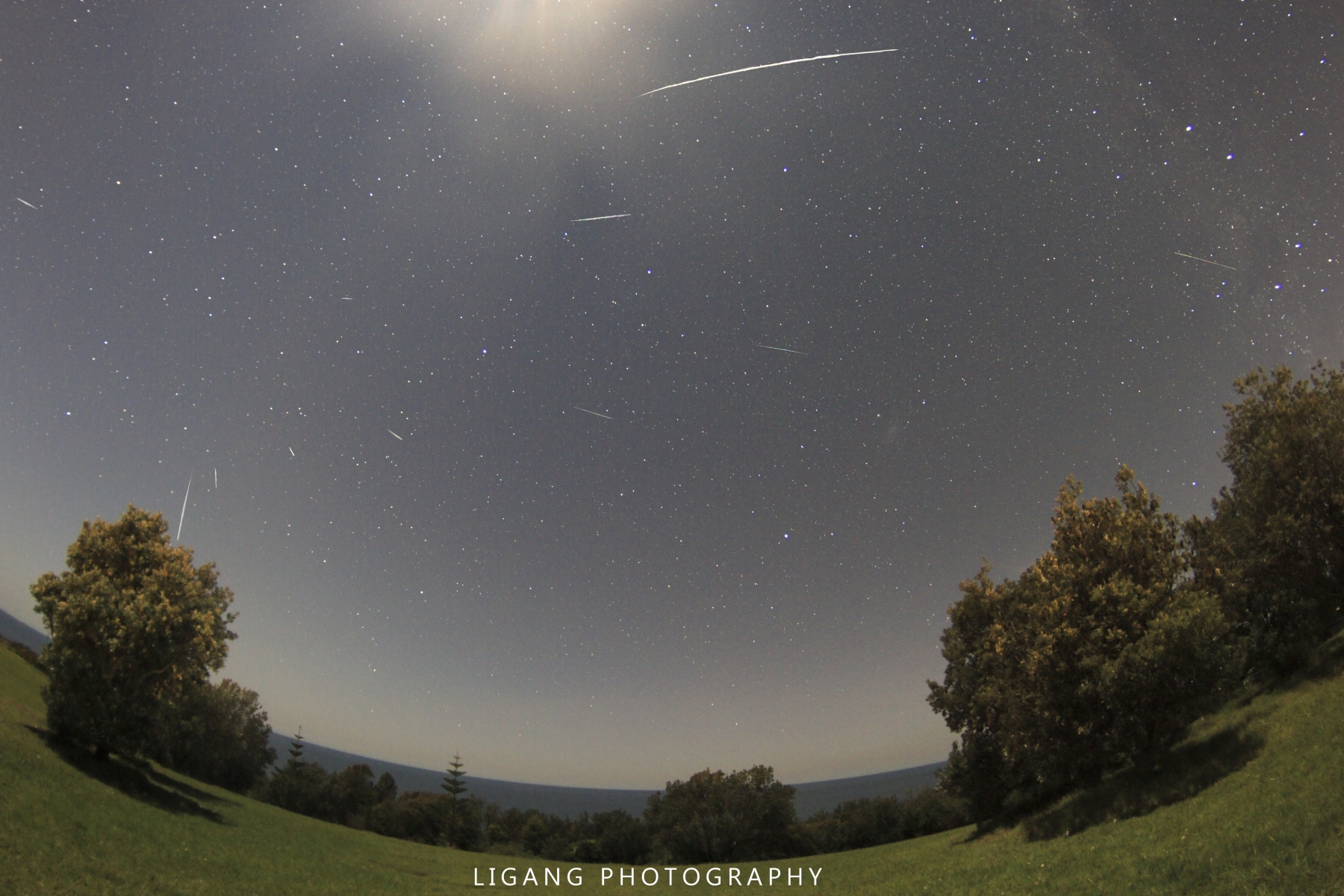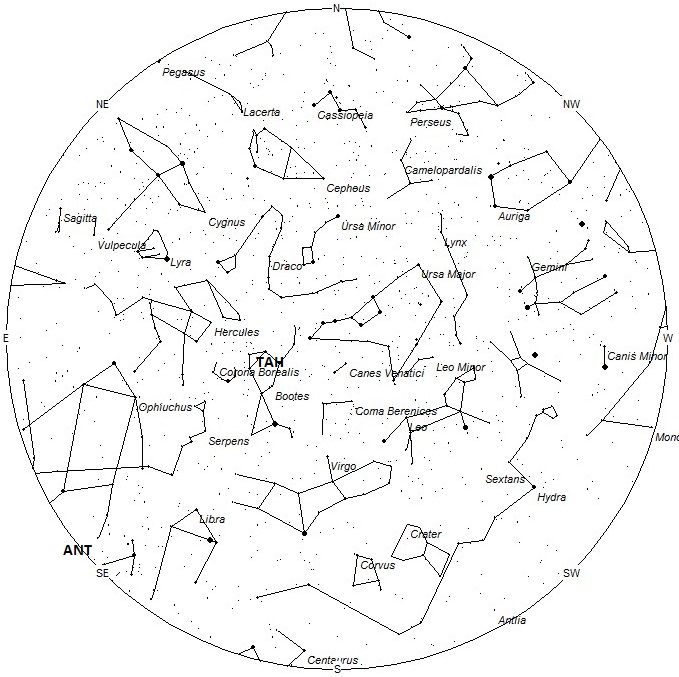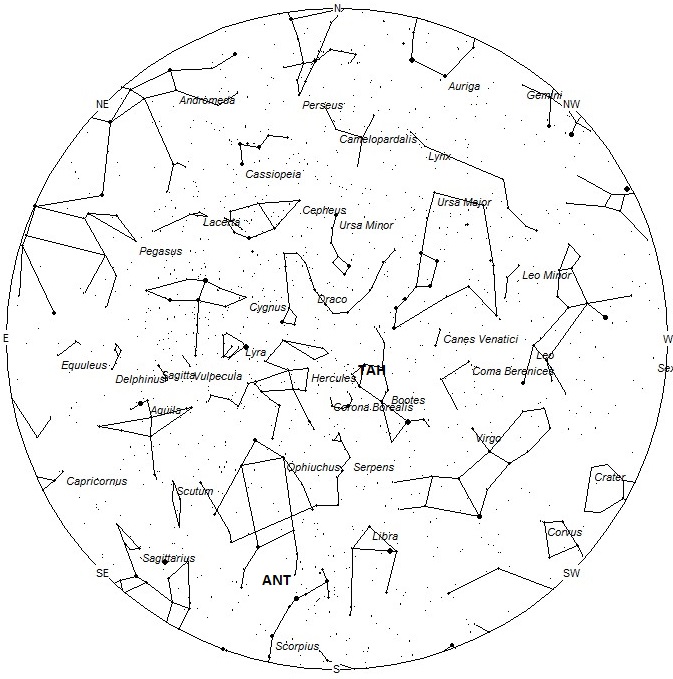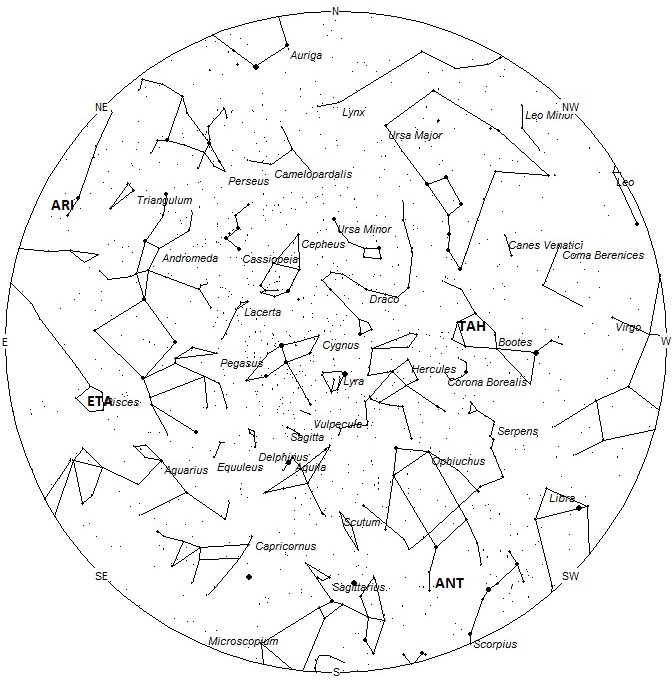 This photo 0f the 2018 eta Aquariids was taken from Gerringong, Sydney, Australia. Exposure 5s, ISO 10000, F/3.5, F=6.5mm. 12 pictures were combined to be the background. The meteors were aligned by Sequator. © Li, Gang
This photo 0f the 2018 eta Aquariids was taken from Gerringong, Sydney, Australia. Exposure 5s, ISO 10000, F/3.5, F=6.5mm. 12 pictures were combined to be the background. The meteors were aligned by Sequator. © Li, GangDuring this period the moon will reach it’s first quarter phase on Tuesday May 22th. At that time the moon will be located 90 degrees east of the sun and set near 0200 local summer time. This weekend the waxing crescent moon will set during the mid-evening hours and will not interfere with meteor observing during the more active morning hours. The estimated total hourly meteor rates for evening observers this week is 3 as seen from mid-northern latitude (45N) and 5 from the southern tropics (25S). For morning observers the estimated total hourly rates should be near 8 as seen from mid-northern latitudes (45N) and 12 from the southern tropics (25S). The actual rates will also depend on factors such as personal light and motion perception, local weather conditions, alertness and experience in watching meteor activity. Note that the hourly rates listed below are estimates as viewed from dark sky sites away from urban light sources. Observers viewing from urban areas will see less activity as only the brighter meteors will be visible from such locations.
The radiant (the area of the sky where meteors appear to shoot from) positions and rates listed below are exact for Saturday night/Sunday morning May 19/20 These positions do not change greatly day to day so the listed coordinates may be used during this entire period. Most star atlases (available at science stores and planetariums) will provide maps with grid lines of the celestial coordinates so that you may find out exactly where these positions are located in the sky. A planisphere or computer planetarium program is also useful in showing the sky at any time of night on any date of the year. Activity from each radiant is best seen when it is positioned highest in the sky, either due north or south along the meridian, depending on your latitude. It must be remembered that meteor activity is rarely seen at the radiant position. Rather they shoot outwards from the radiant so it is best to center your field of view so that the radiant lies near the edge and not the center. Viewing there will allow you to easily trace the path of each meteor back to the radiant (if it is a shower member) or in another direction if it is a sporadic. Meteor activity is not seen from radiants that are located far below the horizon. The positions below are listed in a west to east manner in order of right ascension (celestial longitude). The positions listed first are located further west therefore are accessible earlier in the night while those listed further down the list rise later in the night.
These sources of meteoric activity are expected to be active this week.
The tau Herculids (TAH) are an irregular shower not active every year. They are best known for being associated with comet Schwassmann-Wachmann 3 and the strong display seen in 1930. Due to recent activity from the comet, this shower could produce more activity in the upcoming decade. Little or no activity is expected this year but if it does, the radiant would lie near 14:40 (220) +37. This area of the sky is located in central Bootes, 2 degrees southeast of the 3rd magnitude star known as Seginus (gamma Bootis). This is not that close to the star tau Herculis, for which this shower is named. Apparently the discoverers of this display placed the radiant further east toward Corona Borealis and Hercules. It’s also possible that the shower had a different radiant at that time. This area of the sky is best placed near midnight (LST), when it lies high overhead for observers located in mid-northern latitudes.
The center of the large Anthelion (ANT) radiant is currently located at 16:48 (252) -23. This position lies in southern Ophiuchus, 6 degrees northeast of the bright orange star known as Antares (alpha Scorpii). Due to the large size of this radiant, Anthelion activity may also appear from northern Scorpius and eastern Libra as well as southern Ophiuchus. This radiant is best placed near 0200 LST, when it lies on the meridian and is located highest in the sky. Rates at this time should be near 2 per hour as seen from mid-northern latitudes and 3 per hour as seen from latitude 25 S. With an entry velocity of 30 km/sec., the average Anthelion meteor would be of slow velocity.
The eta Aquariids (ETA) are still active from a radiant located at 23:20 (350) +04. This area of the sky is located in western Pisces, just north of the 4th magnitude star known as gamma Piscium. These meteors cannot be seen prior to 0200 as the radiant lies below the horizon. The best time to view this activity is during the hour before the start of morning twilight, when the radiant lies highest in a dark sky. Current rates would be near less than 1 per hour no matter your location. With an entry velocity of 66 kilometers per second, a majority of these meteors will appear to move swiftly with a high percentage of the bright meteors leaving persistent trains. Surprisingly, this shower produces very few fireballs.
The first members of the Daytime Arietids (ARI) may appear next week from a radiant located at 02:00 (030) +22. This area of the sky is located in western Aries, only 2 degrees southwest of the 2nd magnitude star known as Hamal (alpha Arietis). This area of the sky also lies close to the sun so these meteors can only be seen during the last hour of darkness before dawn becomes too bright. Maximum activity is not until June 7 so little activity is expected to been seen at such an early date. With an entry velocity of 41 kilometers per second, a majority of these meteors will appear to move with medium velocity.
As seen from the mid-northern hemisphere (45N) one would expect to see approximately 6 sporadic meteors per hour during the last hour before dawn as seen from rural observing sites. Evening rates would be near 2 per hour. As seen from the tropical southern latitudes (25S), morning rates would be near 9 per hour as seen from rural observing sites and 4 per hour during the evening hours. Locations between these two extremes would see activity between the listed figures.
| SHOWER | DATE OF MAXIMUM ACTIVITY | CELESTIAL POSITION | ENTRY VELOCITY | CULMINATION | HOURLY RATE | CLASS |
| RA (RA in Deg.) DEC | Km/Sec | Local Summer Time | North-South | |||
| tau Herculids (TAH) | Jun 02 | 14:24 (216) +35 | 15 | 00:00 | <1 – <1 | III |
| Anthelion (ANT) | – | 16:20 (245) -22 | 30 | 02:00 | 2 – 3 | II |
| eta Aquariids (ETA) | May 07 | 22:56 (344) +01 | 66 | 08:00 | <1 – <1 | I |
| Daytime Arietids (ARI) | Jun 07 | 02:00 (030) +22 | 41 | 11:00 | <1 – <1 | IV |







 You saw something bright and fast? Like a huge shooting star? Report it: it may be a fireball.
You saw something bright and fast? Like a huge shooting star? Report it: it may be a fireball.  You counted meteors last night? Share your results with us!
You counted meteors last night? Share your results with us!  You took a photo of a meteor or fireball? You have a screenshot of your cam? Share it with us!
You took a photo of a meteor or fireball? You have a screenshot of your cam? Share it with us!  You caught a meteor or fireball on video? Share your video with us!
You caught a meteor or fireball on video? Share your video with us!